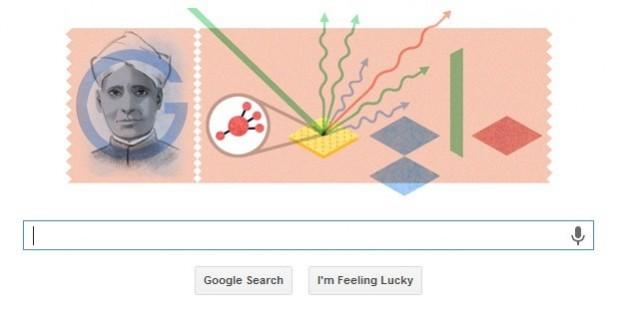Internet giant Google commemorated the 125th birth anniversary of Indian scientist and Nobel laureate CV Raman on Thursday with a doodle demonstrating the Raman scattering and Raman Effect.

The Indian physicist had been immersed in an academic atmosphere since his birth on 7 November 1888 in Trichinopoly district of Madras Presidency (now Tamil Nadu) in British India. His father was a lecturer in physics and mathematics.
After moving to Visakhapatnam of Madras Presidency (now Andhra Pradesh), a 13-year-old Raman entered Presidency College in Madras in 1902. In just two years, he passed the BA examination and also won a gold medal in physics. By 1907, the young genius received his Master's degree with the highest distinctions.
As a student, Raman carried out his earliest researches in optics and acoustics - the two fields to which he dedicated his entire career.
"Real Science begins when we are really interested in something and we try hard to find out the 'why'," he had said during an interview at the Raman Research Institute.
Raman joined government service after college. In 1917, he resigned after being offered a post as a professor of physics at the University of Calcutta.
The golden era of this Indian scientist began when he simultaneously carried out his experimental research in the laboratory of Indian Association for the Cultivation of Science (IACS) in Kolkata. He became the Honorary Secretary in 1919 at IACS.
It was in 1928 when the physicist discovered the phenomenon of Raman scattering that is the result of Raman Effect. The Raman scattering takes place when a ray of light passes through a dust-free, transparent sample of a chemical compound, causing light to emerge in different directions other than that of the incoming beam.
Raman along with co-discoverer of Raman scattering - Kariamanickam Srinivasa Krishnan - was conferred knighthood by the British monarch in 1929. He received medals and honorary doctorates by various universities.
The scientist was earnestly expecting a Nobel Prize that year and was disappointed when the award went to Richardson in 1928 and to de Broglie in 1929.
Raman was convinced of winning the Nobel Prize in Physics in 1930 and he booked tickets in July that year, even though the awards were to be announced in November.
He became the second Indian Nobel laureate, after Rabindranath Tagore, and first Asian to receive any Nobel Prize in science 'for his work on the scattering of light and for the discovery of the Raman Effect'. He is among the few Indian Noble laureates to receive the Bharat Ratna, India's highest civilan award.
A National Science Day is celebrated in India on every 28 February to commemorate his discovery of the Raman Effect in 1928.
After 15 years in Bengal Raman became a professor at the Indian Institute of Science in Bangalore (1933- 1948). He also served as director of the Raman Institute of Research.
Two days before he died of natural causes on 21 November 1970, Raman told one of his former students, "Do not allow the journals of the Academy to die, for they are the sensitive indicators of the quality of science being done in the country and whether science is taking root in it or not."
Here is a rare interview of Sir CV Raman taken at his research institute.


!['Kaise ho bhai..': PM Modi shook hands with Akshay Kumar at a media summit in Delhi [Watch] 'Kaise ho bhai..': PM Modi shook hands with Akshay Kumar at a media summit in Delhi [Watch]](https://data1.ibtimes.co.in/en/full/806317/kaise-ho-bhai-pm-modi-shook-hands-akshay-kumar-media-summit-delhi-watch.jpg?w=220&h=135&l=50&t=40)











!['Kaise ho bhai..': PM Modi shook hands with Akshay Kumar at a media summit in Delhi [Watch]](https://data1.ibtimes.co.in/en/full/806317/kaise-ho-bhai-pm-modi-shook-hands-akshay-kumar-media-summit-delhi-watch.jpg?w=220&h=135)


